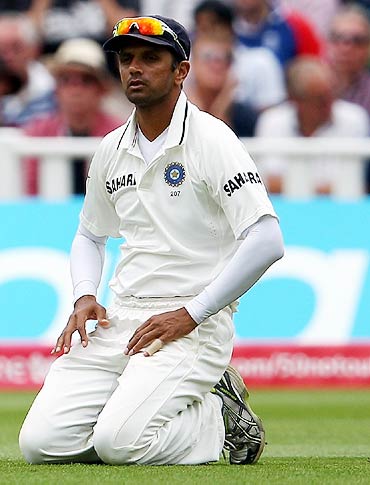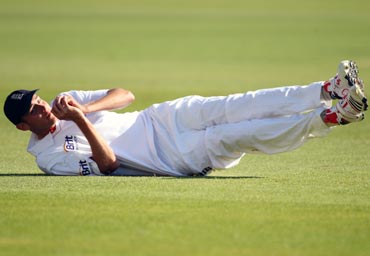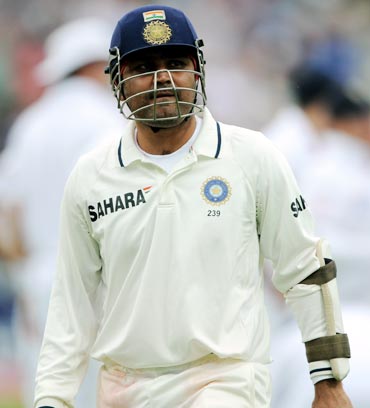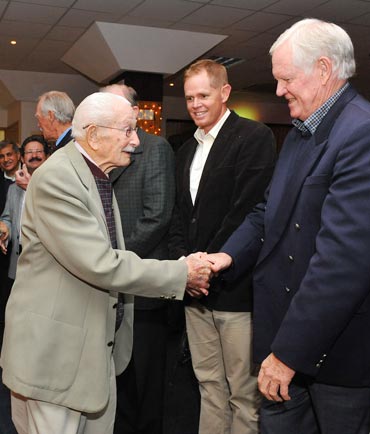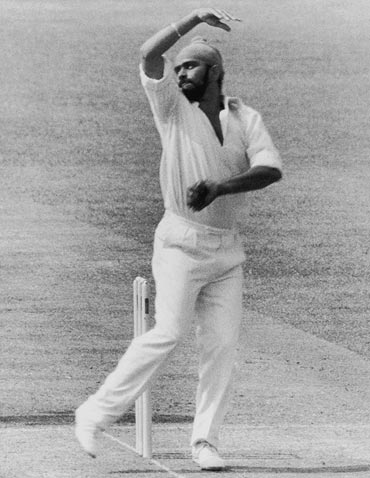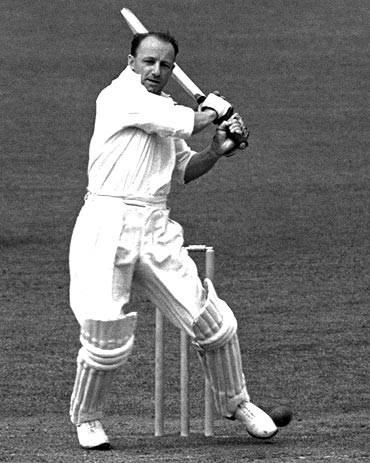 | « Back to article | Print this article |
The oldest Indian team to appear in a Test
If you have a question relating to cricket and did not know who to ask, bounce them off to Rajneesh Gupta. Each week he will pick questions readers send him and provide answers. Your queries should be addressed to: Ask Rajneesh on Facebook or askrajneesh@rediffmail.com
Rajneesh's answers some questions he received from readers last week:
India's poor performance at Edgbaston (particularly the jaded look of the Indian players in the field) made me wonder whether it had something to do with players' ages. I did some number crunching myself and found that the side had three players over-35 (Dravid, Sachin and Laxman) and two players over-30 (Sehwag and Dhoni). Only three players were under-25 (Ishant, Raina and Praveen).
Is there a way to find out which is the oldest Indian team to appear in a Test match? Also, where does the current Indian team stand in that list?
- Kishore Pradhan
Fascinating query, Kishore! It took me quite some time to compile the data, but the end result proved the effort was worth working on. The average age of the Indian team that played at Birmingham was 31 years 188 days at the start of the match, which makes it the eighth oldest Indian team to play in a Test.
The average age of the oldest Indian team to appear in a Test is 32 years 29 days; it was the team that took the field in the first Test of this series at Lord's!
There were six players over-30 in that eleven -- Dravid (38), Tendulkar (38), Laxman (36), Zaheer (32), Harbhajan (31) and Dhoni (30). Abhinav Mukund (21) was the youngest member of the side, followed by Ishant (22), Raina (24), Praveen (24) and Gambhir (29). The side that played in the second Test, at Nottingham, had an average age of 31 years 210 days. So, it seems, you have a point here.
Photographs: Getty Images
Previous column:
- Has any side drawn a four-Test series after trailing 0-2?
When all 10 players were out caught in a Test
Could you please give an instance in ODIs and Test matches where all 10 wickets were bowled or caught or stumped or run-out?
- Amit Behera
There are as many as 48 instances of all 10 players being caught in a Test innings, the most recent was the South Africa against Australia in the first innings of the Durban Test in 2001-02. The record of most players getting bowled in an innings is 9 -- for South Africa against England, in the second innings of the Cape Town Test in 1888-89. Five West Indies players were out stumped (by Kiran More) in the second innings of the Madras Test against India in 1987-88, which is the record of most dismissals in an innings as stumped.
The record of most run-outs is of four, shared by India (v Pakistan in the first innings of the Peshawar Test in 1954-55) and Australia (v West Indies in second innings of Adelaide Test in 1968-69).
In One-Day Internationals, there are 14 instances of all 10 wickets falling as caught, the most recent being New Zealand versus India at Guwahati, last November last year. 8 New Zealand batsmen were dismissed bowled against the West Indies at Berbice in April 1985, which is the record of most bowled in an ODI innings. Most number of batsmen to be dismissed stumped in this format is three -- on 11 occasions. The most-recent being Hong Kong vs India at Karachi in June 2008. Most run-outs in a single innings are five -- on 9 occasions. The latest being Zimbabwe v South Africa at Bulawayo in August 2007.
Best performance by an Indian after a pair
I have a feeling that Virender Sehwag will tear this English attack apart in the Oval Test after registering a golden pair at Edgbaston. Which batsman has played the highest innings in the very next Test after getting a pair? What is the best performance by an Indian after a pair?
- Hitesh Kashyap
West Indies' Clifford Roach scored 209 against England at Georgetown in 1929-30 after getting a pair in his previous Test at Port-of-Spain. Everton Weekes made 197 against Pakistan at Bridgetown in 1957-58 after he bagged a pair against England at the Oval in 1957. Australia's Ricky Ponting also scored 197 against Pakistan at Perth in 1999-00 after getting two ducks against the same opponent at Hobart.
The best effort by an Indian batsman in the very next Test after getting a pair came from Wasim Jaffer, who made 138 (retired hurt) against Bangladesh at Mirpur in 2007 after failing to score in both innings of the previous Test at Chittagong. Dilip Vengsarkar, Yashpal Sharma and Mohinder Amarnath are the other Indians to score a century soon after bagging a pair.
Oldest living Test cricketers from each country
South Africa's Norman Gordon was recently in the news for becoming the first Test cricketer to have lived up to 100 years. Shouldn't India's Cota Ramaswami be holding this record?
Can you please give a list of oldest living Test cricketers from each Test playing country?
- Tanmay Bose
The whereabouts of India's Cota Ramaswami (born on June 18, 1896 is not known).
He walked out of his house in Chennai one day in 1985, at the age of 89 and has not been seen or heard of since then. He is presumed dead by Wisden.
Oldest living Test cricketers from each country:
| Age* | Player | Date of Birth | Tests |
| 100 yrs 9 days | Norman Gordon (South Africa) | 06-08-1911 | 5 |
| 91 yrs 169 days | Reg Simpson (England) | 27-02-1920 | 27 |
| 90 yrs 205 days | Andy Ganteaume (West Indies) | 22-01-1921 | 1 |
| 90 yrs 139 days | Sam Loxton (Australia) | 29-03-1921 | 12 |
| 89 yrs 348 days | Madhav Mantri (India) | 01-09-1921 | 4 |
| 84 yrs 105 days | Israr Ali (Pakistan) | 01-05-1927 | 4 |
| 69 yrs 65 days | Somachandra De Silva (Sri Lanka) | 11-06-1942 | 12 |
| 64 yrs 90 days | John Traicos (Zimbabwe) | 17-05-1947 | 7 |
| 45 yrs 169 days | Enamul Haque (Bangladesh) | 27-02-1966 | 10 |
* as on August 15, 2011
Zimbabwean Vitori outshines Donald
Zimbabwe's Brian Vitori took 5 wickets in each of his first two one-day internationals? Has anyone done this before?
- Ateet Sawant
Zimbabwe's 21-year-old left-arm fast-medium bowler Brian Vitori became the seventh bowler after Sri Lanka's Shaul Karnain, Australia's Tony Dodemaide, South Africa's Allan Donald, Sri Lanka's Charitha Fernando, Canada's Austin Codrington and West Indies' Fidel Edwards to capture five wickets in his debut ODI match when he returned the figures of 5 for 30 in the first ODI against Bangladesh. Vitori bettered his figures with 5 for 20 in the second ODI.
None of the other six players mentioned above managed to pick even a four-for in his second match. So Vitori is the first bowler ever to take five wicket hauls in his first two ODIs.
Two bowlers -- West Indies' Curtly Ambrose and England's Adam Hollioake -- had four-wicket hauls in their first two ODIs.
When India lost a Test after declaring
A team usually declares its innings in a Test when it is confident that it has put up enough runs on the board. Have India ever lost a game after declaring their first or second or both innings?
- Saurabh Agrawal
There are three instances when India declared their innings only to lose the Test.
The first of such instances took place against Australia at Melbourne in January 1948. Australia batted first and posted a total of 394, with Don Bradman scoring 132. India batted resolutely and ended the day two at 262 for six thanks to Vinoo Mankad's 116. However, the overnight rain altered the conditions on day three and batting became extremely difficult. This prompted skipper Lala Amarnath to declare the innings with nine wickets down to take advantage of conditions even though India were 103 behind.
Don Bradman was, however, equal to the task and changed his batting order completely. Ian Johnson and Bruce Dooland, who had batted at # 10 & 9 respectively in the first innings, opened the second innings. Bill Johnston, # 11 in first innings came into bat at # 3. All three failed to make any substantial contribution and were dismissed before Australia's total had crossed 13. Australia also lost Sid Barnes soon, but, by then, the conditions had eased and Don Bradman and Arthur Morris added 223 runs for the fifth wicket without being separated. Chasing a victory target of 359, India were bowled out for 125 in their second innings, giving Australia a win by 233 runs.
Against the West Indies at Kingston in April 1976, India declared their first innings at 306 for six. It was not because they considered themselves strongly placed, but because they did not have any other alternative. The hostile bowling from the West Indies pacers had left Anshuman Gaekwad and Brijesh Patel with injuries that put them out of the match.
Gundappa Viswanath was earlier caught off the glove, the impact leaving a finger both fractured and dislocated. The innings was declared, as captain Bishan Singh Bedi wished to protect himself and Chandrasekhar, both key bowlers, from the risk of injury.
The West Indies replied with 391. India slid to 97 for five in the second innings. At this stage, the innings closed as five batsmen in all absented themselves because of injury.
In addition to Viswanath, Patel and Gaekwad, who were hurt during the Indians' first innings, Bedi and Chandrasekhar had damaged fingers while attempting return catches during the West Indies' innings.
At first it was thought that Bedi had declared again -- with India only 12 runs in front -- and it was only after the West Indies won that a statement was issued by Bedi that the Indian innings should be recorded as completed.
The third and last such instance occurred against Australia at Perth in December 1977. Captain Bedi declared India's second innings at 330 for nine, giving Australia a fourth-innings winning target of 339 runs. Australia won by two wickets with 22 balls to spare.
Australia top the list of maximum double-centuries
How many double centuries have been scored in Test cricket? Which side has scored most double centuries and which has conceded most?
- Hari Balan
When Alastair Cook made 294 at Edgbaston, it was the 305th double ton in Test cricket.
Australia top the list of maximum double-centuries scored by a team (62), followed by England (50), West Indies (47, India (40), Pakistan (33), Sri Lanka (29), South Africa (24), New Zealand (16) and Zimbabwe (4).
England have conceded the most double centuries (62), followed by India (45), New Zealand (38), Australia (35), West Indies (30), Pakistan (30), South Africa (23), Sri Lanka (18), Bangladesh (14) and Zimbabwe (10).
Highest innings by Indians for the fewest balls
Praveen Kumar played a little cameo scoring 40 off 18 balls in India's second innings at Birmingham. Can you list the highest innings by Indian players for the fewest balls faced.
- Gaurav Verma
Here is the list prepared after going through all the innings for which balls faced information is available. Ishant's case is unique as he played only one ball and scored five (with the help of over-throws). Sehwag appears five times, Kapil Dev four times, Azharuddin thrice, and Ishant, VRV Singh, Praveen Kumar and MS Dhoni once each.
| Runs | Balls | Player | Against | Venue |
| 5* | 1 | Ishant Sharma | v Sri Lanka | Colombo SSC, 2008 |
| 11 | 4 | VRV Singh | v South Africa | Johannesburg, 2006-07 |
| 23* | 10 | Kapil Dev | v England | Lord's, 1986 |
| 40 | 18 | Praveen Kumar | v England | Birmingham, 2011 |
| 89 | 55 | Kapil Dev | v England | Lord's, 1982 |
| 109 | 77 | Mohd Azharuddin | v South Africa | Kolkata, 1996-97 |
| 116 | 98 | Kapil Dev | v England | Kanpur, 1981-82 |
| 121 | 111 | Mohd Azharuddin | v England | Lord's, 1990 |
| 131 | 122 | Virender Sehwag | v Sri Lanka | Kanpur, 2009-10 |
| 148 | 153 | MS Dhoni | v Pakistan | Faisalabad, 2005-06 |
| 163 | 165 | Kapil Dev | v Sri Lanka | Kanpur, 1986-87 |
| 182 | 197 | Mohd Azharuddin | v England | Kolkata, 1992-93 |
| 201* | 231 | Virender Sehwag | v Sri Lanka | Galle, 2008 |
| 254 | 247 | Virender Sehwag | v Pakistan | Lahore, 2005-06 |
| 293 | 254 | Virender Sehwag | v Sri Lanka | Mumbai (BS), 2009-10 |
| 319 | 304 | Virender Sehwag | v South Africa | Chennai, 2007-08 |
Cook's unique feat
At Edgbaston, Alastair Cook's score (294) was more than India's either innings (224 & 244). Is there any batsman, whose innings runs were actually more than the opposition's two innings put together?
-Naveen Bhosale
Five batsmen have achieved this ultimate feat, Naveen.
They are listed here-under in the chronological order:
| Batsman | Score | Opponents (Totals) | Venue | Season |
| R Abel (Eng) | 120 | South Africa (47 & 43) | Cape Town | 1888-89 |
| L Hutton (Eng) | 364 | Australia (201 & 123) | The Oval | 1938 |
| DG Bradman (Aus) | 185 | India (58 & 98) | Brisbane | 1947-48 |
| Inzamam-ul-Haq (Pak) | 329 | New Zealand (73 & 246) | Lahore | 2001-02 |
| ML Hayden (Aus) | 119 | Pakistan (59 & 53) | Sharjah | 2002-03 |
